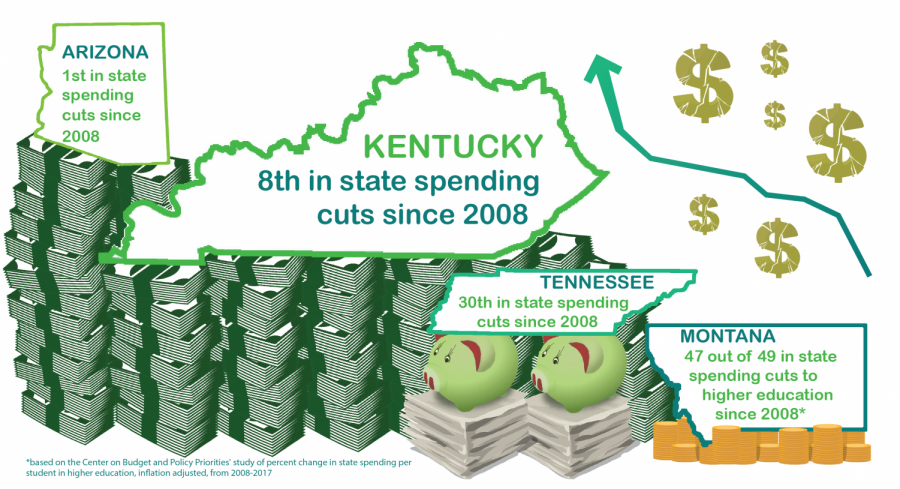Kentucky ranks in the bottom 10 for state cuts to higher education
August 30, 2017
BALANCING ACT
Kentucky has made some of the largest budget cuts to higher education in the last several years, according to a recent study by the Center on Budget and Policy Priorities.
The study found that state spending on higher education across the nation remains below pre-recession levels in 2008, and the cost of tuition has continued to rise despite continued higher education budget cuts at the state level.
The study found Kentucky was spending 26.4 percent less per student compared to 2008, or spending about $2,832 less per student. Kentucky was ranked in the bottom 10 on the list of budget cuts to higher education since 2008.
In Kentucky, the average price of tuition at a public four-year college has risen by 36.9 percent since 2008, according to the study. The state with the highest percent increase in tuition was Louisiana, whose tuition has increased 100.7 percent since 2008.
In Montana, however, tuition has risen only 4.4 percent since 2008. Last year alone, WKU raised tuition by 4.5 percent.
Despite heavy cuts in recent years, the study found most states were beginning to put money back into higher education. For the 2016-2017 school year, 37 states increased spending on higher education. However, Kentucky was not one of those states.
In the 2016-2017 school year, Kentucky cut state spending on higher education by 1 percent, or about $78 per student.
“The issue is obvious,” Ann Mead, senior vice president of finance and administration at WKU, said. “Kentucky is struggling to fund that which needs to be funded.”
Mead cited several areas of the state budget that are underfunded: infrastructure, public schools and higher education. Mead said though the economy has improved nationally, “Kentucky has not had the capacity” to reinvest in areas that have suffered cuts.
Despite the large cuts to higher education, Mead said those cuts are not as a result of the state’s lack of commitment to higher education.
“It’s a testimony to the overall weakness of our economy,” Mead said. “Capacity is not there.”
WKU has not been immune to state budget cuts. For fiscal year 2017, WKU had over $6 million in budget reductions, while raising tuition by 4.5 percent.
Several programs had their budgets cut or were eliminated across the university, including spousal tuition benefits, which will be reinstated this year, moving building and groundskeeping employees to Sodexo and cuts to the track and field program. Several other programs saw cuts or consolidation, including the consolidation of the Institute for Citizenship and Social Responsibility and the Alive Center.
Last year, WKU turned to carry forward funds to help alleviate budget cuts. However, according to President Timothy Caboni, using carry forward funds is not a sustainable option for WKU. During a meeting with members of the Herald editorial board, Caboni said “carry forward works for this year,” but a new plan will need to be made for the future.
Mead said carry forward funds have been revised recently, and those funds will be coming centrally to the university, rather than distributed by department, until the total budget deficit is known. Mead also reiterated that using carry forward funds is a “one-time solution” for WKU.
Caboni has made it clear budget reorganization is on his list of priorities. During the same meeting with members of the Herald editorial board, Caboni said he is challenging the budget committee to “come back with how we work through the budget deficit.”
Although the full extent of WKU’s budget deficit for this year will not be known until October, Caboni estimated there would be a deficit somewhere between $11 million to $15 million.
Mead said under the current approved operating budget, WKU “budgeted in anticipation of $11 million” as a deficit. However, Mead said there were still a large number of variables that could determine the final deficit and she couldn’t predict what that deficit may be at this time.
Mead said WKU has an unrestricted educational and general budget of approximately $334 million for 2017-2018, and she anticipated WKU “would have sufficient one-time money to allow us to have a balanced budget by June 30.”
“The real challenge is what needs to be done for the next budget so we’re not dealing with carrying that deficit forward,” Mead said.
Additionally, the performance-based funding model goes into effect this academic year. In April, former president Gary Ransdell said WKU would receive over $3.8 million from the performance-based funding model. Funds will be distributed based on the number and types of bachelor’s degrees awarded by the university and student progress compared to other state universities.
While Kentucky’s cuts to higher education have been deep, other states have been deeper. Arizona, which was ranked as first in state spending cuts for higher education, is spending 53.8 percent less per student than in 2008. Wyoming had the largest cuts for the 2016-2017 academic year, with 9.2 percent spent cut from higher education, according to the study.
Illinois, which went over two years without a state-approved budget, went just as long without state funding for higher education.
News editor Monica Kast can be reached at 270-745-6011 or [email protected].




















![Students cheer for Senator at Large Jaden Marshall after being announced as the Intercultural Student Engagement Center Senator for the 24th Senate on Wednesday, April 17 in the Senate Chamber in DSU. Ive done everything in my power, Ive said it 100 times, to be for the students, Marshall said. So, not only to win, but to hear that reaction for me by the other students is just something that shows people actually care about me [and] really support me.](https://wkuherald.com/wp-content/uploads/2024/04/jadenmarshall-600x422.jpg)





